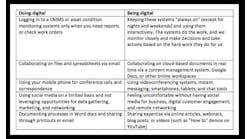A single source of configuration truth: Your success metric for Industry 4.0
The manufacturing sector has been undergoing a significant digital shift in the past few years. You already know this. Industry 4.0 enables smart factories that can run themselves by using the most recent advancements in robotics, Internet of Things (IoT) sensors, artificial intelligence and communication technologies.
Manufacturers must establish a collaborative single-source-of-configuration-truth to improve product time-to-market and increase product quality in the face of Industry 4.0 disruption arising from increased product complexity.
Let’s consider how to make this happen...
Industry 4.0 factors creating industry shifts
First, we must consider three of the factors responsible for creating shifts in manufacturing:
1. New customer demands: Personalization is one of the top 10 strategic trends for manufacturing businesses, according to Gartner. A single, shared understanding of what is achievable and what is not is necessary for further personalization and customization, as well as agility and flexibility.
2. Adapting to new business models: By experimenting with new business models for how they provide value, manufacturers are responding to changing technology demands as well as changing consumer demands for personalization and customization.
3. Servitization and its impact: Servitization returns ownership of a product back to the manufacturer, along with the cost of care and maintenance that this entails. Consequently, manufacturers must design for inexpensive maintenance as they become more aware of the operational efficiency of their products.
Some manufacturers are increasing the amount of software in their devices as a result of this model. By making more generic goods, options and configurations can be enabled with software by field technicians or the customers themselves.
It’s vital that the rules regulating configuration possibilities are consistent, from engineering through production to sales and service, in order for this strategy to provide a low-cost maintenance solution.
Preparing for digital transformation
There are two important steps to take to prepare for digital transformation. The first is to remove silos to create interconnected systems. Most manufacturers use dozens of different software programs to control every element of their business, from production to sales and fulfillment. For the benefit of the sales teams, dealers and customers, information and capabilities are combined.
The second is to consider the role of CLM. Product configuration is one of the areas that the aforementioned trends are most directly affecting. Many manufacturers struggle with products that offer a wide range of alternatives, resulting in thousands of possible configurations—even without modification and personalization. Knowing what can’t be done is just as important as knowing what can be done, if not more so. This holds true not only for the initial product design but also for real-time situations where there may be problems with the supply of materials and parts required for particular configuration possibilities.
These are the challenges that configuration-lifecycle management (CLM) solutions address.
Creating a single source of truth
A CLM methodology offers a way to define and manage the rules that control how product options can be mixed and matched to create certain configurations. Once these rules are established, they offer a single source of truth for product-configuration data that can be used end-to-end, from design to production, sales and support. This is where CLM truly shines.
There are countless possible choice combinations for any new product design up for consideration. These options can be considered and saved, along with the regulations governing the viability of configuration options, when CLM is used in the product-planning stage. Depending on their needs, various users can receive different views of this aggregated information.
Join the transformation
The advent of digital transformation means greater opportunity...if you can keep up. You’ll need to make a conscious decision to compete smarter, faster and more fiercely in the future. Manufacturers who are successful in their digital transformation begin by streamlining every area of their businesses, especially those that are closest to the consumer.
Manufacturing enterprises are expanding more quickly by combining the numerous front-end procedures made possible by customer-relationship management, configure/price/quote tactics, and product-configuration tools with back-end procedures. They are adopting configuration-lifecycle management, an end-to-end system, as the cornerstone of their digital business transformation.
By Henrik Hulgaard, CTO and co-founder of Configit


